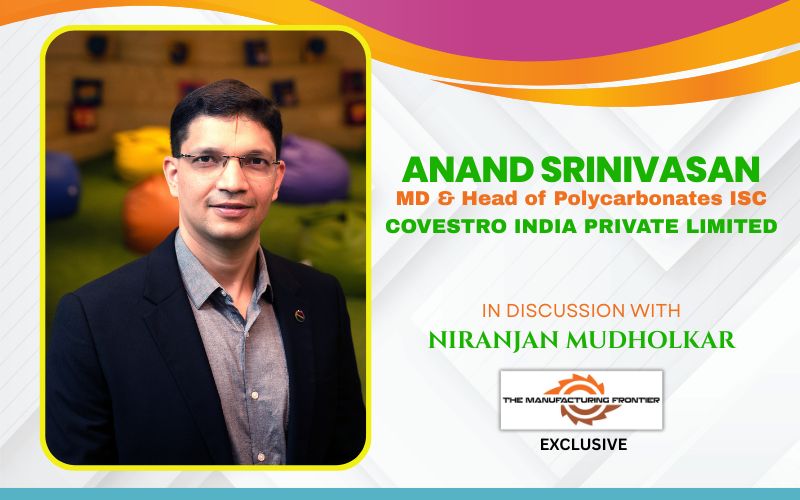“The polycarbonate’s role is preventive: protecting against external triggers and helping delay thermal propagation between cells through their thermal stability and dimensional integrity, providing crucial time for safety systems to activate.” Anand Srinivasan, Managing Director & Head of Polycarbonates ISC, Covestro India Private Limited
Can you please elaborate on why polycarbonates are emerging as crucial materials in the design and manufacturing of next-generation electric vehicle batteries? What makes them stand out compared to traditional materials?
Polycarbonate (PC) compounds have established itself as the material of choice for EV battery design by addressing multiple critical challenges simultaneously. These advanced materials, such as Covestro’s Bayblend® PC+ABS blends, excel in thermal stability across temperature ranges of battery usage, ensuring consistent battery performance while meeting strict flame-retardancy standards. Their amorphous polymer structure makes them dimensionally stable with predictable reproduction of designs, without using dense reinforcements, making them lightweight.
Bayblend® PC+ABS blends have been the industry standard for Lithium-Ion battery pack solutions in electrical, consumer electronics applications. Covestro, being among the leaders in the Mobility and Electronics & Electricals segment, has synergized the expertise from both to curate purpose-engineered portfolio for electric vehicle batteries.
Battery safety is paramount in EV design. Could you delve into the specific technical advantages of using polycarbonates in battery casings and enclosures? How do properties like impact resistance and flame retardancy contribute to enhanced safety performance in the event of an accident or thermal runaway?
It is important to understand that thermal runaway in battery cells primarily originates from internal cell failures or external triggers unrelated to enclosure materials and once a thermal runaway initiates within a cell, polymer enclosure materials cannot effectively contain the extreme temperatures. The polycarbonate’s role is preventive: protecting against external triggers and helping delay thermal propagation between cells through their thermal stability and dimensional integrity, providing crucial time for safety systems to activate.
Covestro’s engineering plastics help to prevent these external triggers from initiating thermal events. The impact-resistant honeycomb structure protects against mechanical deformation, while high Comparative Tracking Index (CTI) grades like Bayblend® FR3015 CTI prevent electrical tracking that could cause short circuits, and the flame-retardant properties ensure the enclosure doesn’t contribute as fuel during a thermal event.
“The absence of reinforcement itself will significantly reduce the part weight due to lower density of material and possibility of thin wall designs due to excellent impact properties can further help reduce weight.”
Lightweighting is another critical factor for improving EV efficiency and range. Can you explain how the use of polycarbonate components, such as cell holders and structural elements within the battery pack, contributes to overall vehicle weight reduction without compromising structural integrity or safety?
Unlike the semi-crystalline polymers requiring 30-50% glass fiber loading to achieve an acceptable level of dimensional stability and thermal stability across battery operating temperatures, polycarbonates have inherent thermal properties while maintaining excellent dimensional stability with no or minimal reinforcement. The absence of reinforcement itself will significantly reduce the part weight due to lower density of material and possibility of thin wall designs due to excellent impact properties can further help reduce weight.
Thermal management is vital for optimal battery performance and longevity. How do Covestro’s polycarbonates contribute to effective thermal insulation within EV battery systems? Are there specific grades or applications where their thermal properties are particularly advantageous?
Covestro’s engineering plastic materials work together in a comprehensive thermal management strategy. The standard EV grades work complementarily with various thermal management materials such as Phase Change Materials (PCM) and a wide range of thermal interface solutions. For direct contributions, the conductive grades from Makrolon TC portfolio helps in heat transfer in critical areas, reducing the system temperature and reducing the temperature difference across the pack, easing thermal management. In active cooling designs, the hydrolysis resistant grades such as Makrolon® FR6020 and Bayblend® FR4065EV provide a combination of design flexibility of molded in coolant channels and coolant-resistance. A pack specific design leveraging these combination of materials help optimize battery performance, extend life cycles, and maintain safety across various operating conditions.
“With the advancement of high-speed charging and augmentation of battery capacities to increase the driving range, the battery packs are shifting to high voltage architecture for better thermal management and reduce the use of high-cost copper required to manage high current systems.”
Considering the rapid advancements in battery technology, what future innovations or adaptations do you foresee for polycarbonates in addressing the evolving needs of EV battery design and manufacturing? Are there any emerging trends that you find particularly exciting?
From our own Hermann Schnell pioneering polycarbonate development in 1953 at Bayer lab to today’s advanced portfolios specifically engineered for e-mobility, Covestro continues its legacy of innovation by developing sustainable, high-performance materials that enable the next generation of safer, more efficient electric vehicles. We currently address emerging EV battery trends such as high voltage architecture, change in cell formfactors and cell to pack (CTP) design, through specialized material solutions. The shift toward cell-to-pack architecture leverages the inherent advantages of amorphous polymers, whose exceptional dimensional stability and low warpage are crucial for longer, thinner components. This precision is essential for efficient automated assembly and long-term reliability.
With the advancement of high-speed charging and augmentation of battery capacities to increase the driving range, the battery packs are shifting to high voltage architecture for better thermal management and reduce the use of high-cost copper required to manage high current systems. A pathbreaking combination of 600V CTI as per IEC60112 and amorphous polymers in our high CTI portfolio meets the demands of 800V and higher systems in battery packs and charging infrastructure, preventing electrical tracking and surface degradation under intense electrical stress.
Additionally, the UV transparency engineered in our Bayblend® FR3040EV enables UV-curable adhesive usage, significantly reducing production cycle times compared to traditional thermal curing methods. This grade is the material of choice in high-speed electric scooters and motorcycles in India, owing to the tailor-made properties for efficient manufacturing.
These complementary solutions – high CTI grades for electrical safety, dimensionally stable grades for structural components, and UV-transparent grades for efficient assembly – position Covestro at the forefront of next-generation EV battery design, supporting the industry’s evolution toward higher performance and improved manufacturing efficiency.
From a manufacturing perspective, what are the key processing advantages of using polycarbonates in battery components? Are they easily integrated into existing manufacturing processes, and do they offer any benefits in terms of production efficiency or cost-effectiveness?
Polycarbonates integrate seamlessly into existing injection molding processes used widely in the industry, enabling direct adoption with standard equipment. Building on our earlier discussion about the amorphous nature providing adequate properties without requiring extensive glass fiber reinforcement, polycarbonates help lower tool and machines wear synonymous with glass filled semi crystalline materials, saving long term costs.
Bayblend® PC+ABS grades are known to fill the parts without needing high injection pressure, as against some of the competing materials, resulting in minimal molded-in stress. On one hand, minimal molded-in stresses can ensure better part reliability, on the other hand it can enable the use of smaller injection molding machines and less complex tooling designs, reducing capital investment.
Covestro’s commitment to sustainability is reflected in our CQ (Circular Intelligence) portfolio, offering both ISCC certified, mass-balanced renewable attributed grades (RE series) as drop-in solutions and post-consumer recycled (PCR) materials with varying recycled contents (R series). This versatile portfolio can help the manufacturers to reduce carbon footprint without needing to spend more on tooling and design changes.
“Covestro offers comprehensive technical support throughout the development process, from material selection and design optimization to processing guidance, leveraging our strong Application Development team.”
For engineers and designers working on EV battery development, what key considerations should they keep in mind when evaluating and selecting polycarbonate materials for their applications? What are some critical performance parameters to focus on?
The material selection should consider the component’s specific requirements, based on the thickness at which the fire-retardant rating is required, the level of mechanical and electrical stress the application will undergo, the regulatory requirements of the respective regions and the type of vehicles, the type of materials with which the parts will be in contact, among others.
Covestro offers comprehensive technical support throughout the development process, from material selection and design optimization to processing guidance, leveraging our strong Application Development team. Their expertise includes CAE analysis support, mold flow studies, thermal simulation, ensuring optimal material selection and application success. This partnership approach helps streamline development cycles and optimize component performance.
Our dedicated resources in India support mobility electrification needs, helping partners achieve efficiency across product development cycle, leveraging our global expertise.

